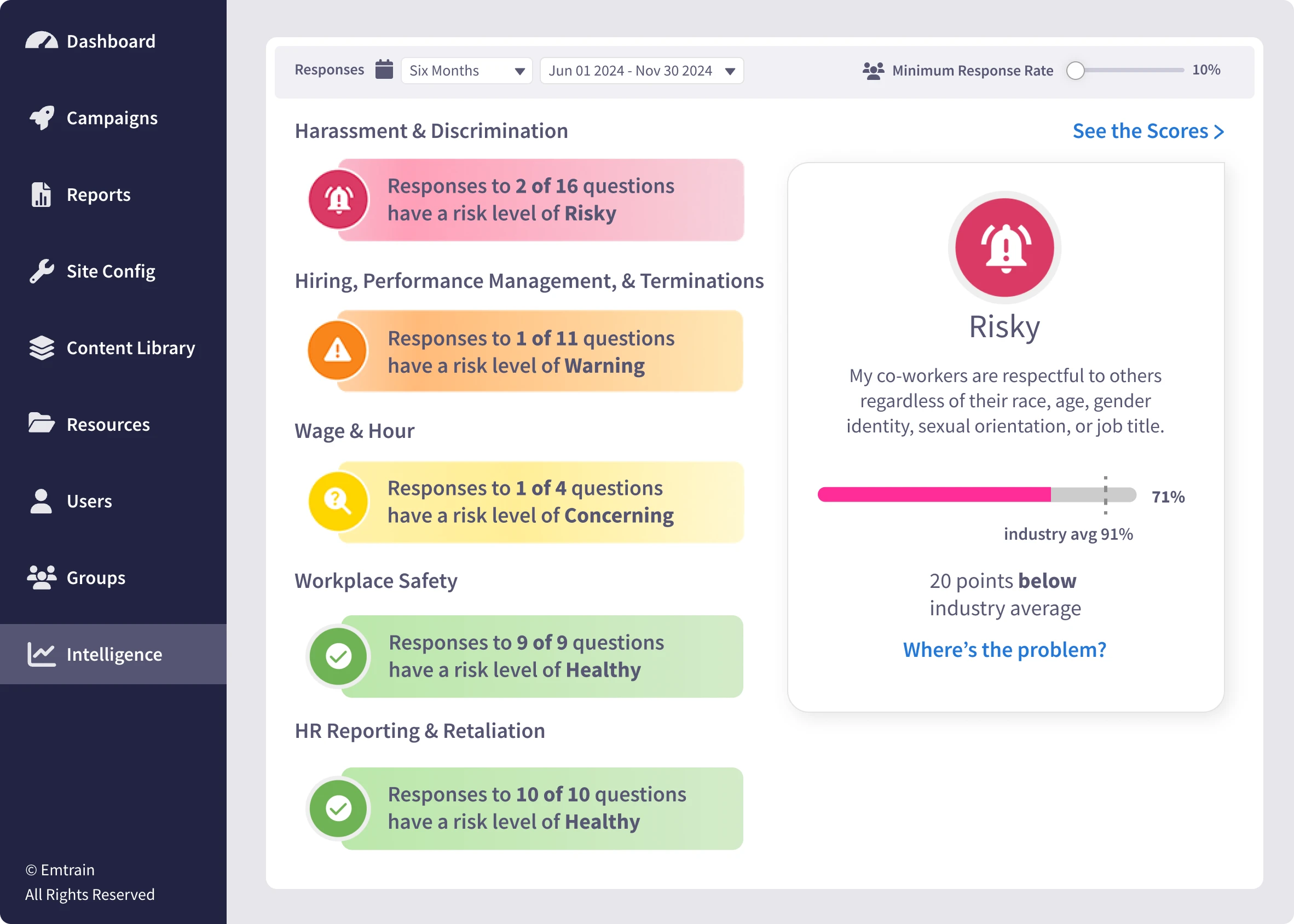Home » Concepts » Discrimination & Harassment » Bystander to upstander
The concept of shifting from a passive observer (bystander) to someone who actively intervenes or takes action against inappropriate or harmful behavior (upstander). In a workplace setting, upstanders help create a more inclusive, respectful, and safe environment by responding to issues like harassment, discrimination, or bullying.
Emtrain’s harassment training course is engaging, interactive, and designed to spot and reduce EEO risk.

The idea of upstander behavior emerged from studies of social psychology, particularly from research on the “bystander effect,” where individuals are less likely to help in group settings. This concept gained traction in workplace training as a response to rising concerns about harassment, discrimination, and inclusion. Following the #MeToo movement and broader social justice awareness, bystander intervention has become a standard best practice in compliance and Inclusion training.
A bystander is someone who observes inappropriate, harmful, or biased behavior in the workplace but does not take action to intervene. While their presence can validate the seriousness of the incident, inaction—whether due to uncertainty, fear, or lack of tools—can unintentionally allow harmful behaviors to continue unchecked.
An upstander is someone who chooses to act when they witness inappropriate behavior. This can include speaking up in the moment, offering support to those affected, reporting concerns, or modeling inclusive behavior. Upstanders help build a workplace culture where empathy, safety, and accountability are the norm, not the exception.
Bystander intervention involves recognizing a harmful situation and choosing a safe and effective response. It can include:
Direct: Speaking up or intervening in the moment.
Distract: Redirecting attention or changing the subject.
Delegate: Seeking help from HR, a manager, or another authority.
Delay: Checking in with the impacted person later.
Upstanders play a critical role in shaping a respectful and inclusive workplace. When individuals choose to step in—whether by speaking up, offering support, or redirecting harmful behavior—they help create a culture where inappropriate conduct is addressed early, not ignored. Upstanders not only protect their peers, they also reinforce company values, reduce legal and reputational risk, and demonstrate what accountability looks like in action.
Here’s how upstanders make a difference:
Help de-escalate harmful situations
Early intervention can prevent situations from escalating into formal complaints or long-term conflict.
Support affected individuals
A simple act of allyship can make someone feel seen, validated, and safe.
Encourage organizational accountability
When employees speak up, it signals to leadership that workplace culture matters.
Model inclusive behavior and workplace values
Upstanders set a visible example that others can follow, reinforcing a positive workplace norm.
Contribute to proactive risk reduction
Identifying and addressing inappropriate behavior early helps organizations reduce legal liability—aligning with Emtrain’s compliance intelligence goals.
Workplace misconduct doesn’t always show up in overt or headline-grabbing ways. Often, it’s subtle, repeated behavior—jokes, comments, or patterns of exclusion—that erode trust, morale, and inclusivity over time. Recognizing these common scenarios is the first step in shifting from passive observation to proactive intervention. Below are a few real-life situations where bystanders have the opportunity to become upstanders and positively influence workplace culture.
Harassment from clients or vendors
Microaggressions tied to race, gender, disability, or religion
Teaches employees how to manage emotional responses and remain calm in difficult situations. Empathetic upstanders are more likely to support colleagues and respond thoughtfully rather than reactively.
Helps employees identify subtle forms of bias—both in themselves and others. Awareness is the first step in knowing when and how to intervene appropriately when bias affects team interactions.
Prepares employees to handle inappropriate behavior from external parties while maintaining professionalism. It empowers bystanders to advocate for themselves or teammates when customer or client conduct crosses the line.
Addresses harmful conduct that happens outside traditional work channels. Employees learn when to speak up and how to support others affected by digital harassment or reputational harm.
Helps uncover unconscious behaviors that can harm others. Teaching employees to spot these moments enables them to speak up before small issues escalate into bigger problems.
Raises awareness of common stereotypes and microaggressions targeting Asian colleagues. By recognizing these patterns, employees can challenge inappropriate comments and support more inclusive team dynamics.
Equips employees to recognize and confront anti-Muslim bias in the workplace. Builds confidence in stepping in when someone is being marginalized based on religion or appearance.
Promotes a speak-up culture where concerns are surfaced early. When employees know their voice is valued and protected, they’re more likely to become upstanders.
Fosters a culture of belonging by showing how to structure conversations that include every voice. Equips employees to redirect exclusionary behavior and ensure participation is fair and respectful.
Courses That Support Bystander Development
Preventing Workplace Harassment (US, UK, Canada, Global, India)
Blog: American but Asian: The anti-Asian turning point
An Asian American woman recounts a painful experience of public harassment rooted in racism, highlighting the surge of anti-Asian sentiment.
Blog: How to Be an Upstander in the Workplace
Here are three ways your managers and employees can proactively be an upstander for any colleague, especially during sensitive times.
Video: The Upstander | Being a Good Bystander
Video Preview: Four examples of how to be an ally in the workplace, using direct and subtle interventions.